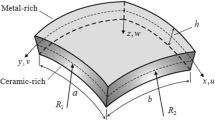Abstract
Stress intensity factors and crack opening displacements are presented for infinite pairs of surface cracks in plates subjected to remote tension by using the three dimensional weight function method developed in [7,8]. A wide range of configuration parameters is considered. The results compare very well with double edge cracks as crack aspect ratio tends to zero; with collinear cracks as it tends to infinity; with a pair of surface cracks in a wide plate when the ratio of crack length to plate width is small; and with a single surface crack in large plates when both the ratios of crack length to plate width and crack depth to plate thickness are small. Also illustrated is the significant difference between a single surface crack and the surface cracks in pairs when the ratio of crack depth to plate thickness is large.
Similar content being viewed by others
References
J.C. Newman, Jr., and I.S. Raju, NASA TP-1578 (1979).
T.Nishioka and S.N.Atluri, Engineering Fracture Mechanics 17 (1983) 247–268.
X.R.Wu, Engineering Fracture Mechanics 19 (1984) 387–405.
T.A. Cruse, in Fracture Mechanics: 19th Symposium, ASTM STP 969 (1988) 19–42.
I.S. Raju, S.N. Atluri and J.C. Newman, Jr., in Fracture Mechanics: 20th Symposium, ASTM STP 1020 (1987) 297–316.
J.C. Newman, Jr. and I.S. Raju, in Computational Methods in the Mechanics of Fracture, Elsevier Science Publishers B.V. (1986) 311–334.
W.Zhao, X.R.Wu and M.G.Yan, Engineering Fracture Mechanics 34 (1989) 593–607.
W. Zhao, ‘Weight function theory and applications for analysis of three-dimensional crack problems’, Ph.D. thesis, Institute of Aeronautical Materials (1988).
W.Zhao, X.R.Wu and M.G.Yan, Engineering Fracture Mechanics 34 (1989) 609–624.
W.Zhao and X.R.Wu, Fatigue and Fracture of Engineering Materials and Structures 13 (1990) 347–360.
W.Zhao and X.R.Wu, Theoretical and Applied Fracture Mechanics 13 (1990) 225–238.
X.R.Wu, Engineering Fracture Mechanics 20 (1984) 35–49.
R.J.Hartranft and G.C.Sih, in Methods of Analysis and Solutions to Crack Problems, Vol. 1, Noordhoff International Publishing, Leyden (1973) 177–238.
W.Zhao, Engineering Fracture Mechanics 38 (1991) 313–319.
H.F.Bueckner, ZAMM 50 (1970) 529–546.
J.R.Rice, International Journal of Solids and Structures 8 (1972) 751–758.
X.R.Wu and J.Carlsson, Journal of Mechanics and Physics of Solids 31 (1983) 485–497.
Y. Murakami et al., Stress Intensity Factors Handbook, Pergamon Press (1987).
K.Hayashi and H.Abe, International Journal of Fracture 16 (1980) 275–285.
Author information
Authors and Affiliations
Rights and permissions
About this article
Cite this article
Zhao, W. Analyses of infinite pairs of surface cracks in elastic plates. Int J Fract 55, 143–152 (1992). https://doi.org/10.1007/BF00017274
Received:
Accepted:
Issue Date:
DOI: https://doi.org/10.1007/BF00017274




